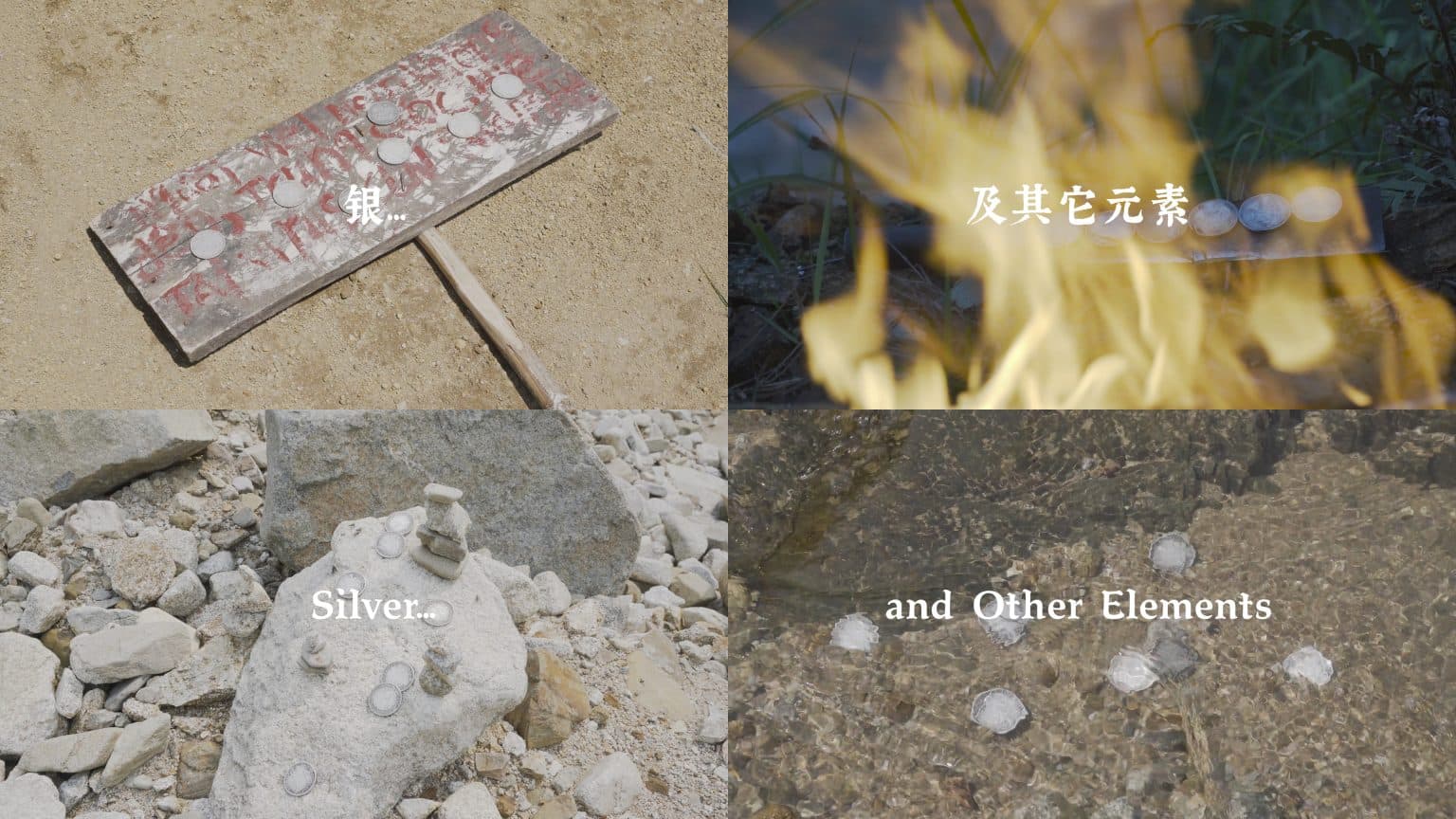Silver… and Other Elements銀… 及其它元素
Pan told the origins of the seven “Old Coins” he owned in this video, along with the moving of the borderline, the migration of the people, the wind, the rivers, the mountain and the forests.
The Mang people had to constantly adapt to these shifting borders and spaces, and the accompanying changes in discourse and symbolic systems, as the relations between the two countries evolved. A striking example is the use of coins: during the Qing dynasty, the Mang people used copper coins made by the Qing government, while with the occupation of Vietnam by the French colonialists, the Piastre, a silver coin issued by France for trade in Southeast Asia, became the dominant currency there. With the re-independence of Vietnam in the mid-twentieth century and the establishment of the new China, the local currency changed further. Interestingly, however, the silver dollar has somehow survived in the Mang community: no longer as money, but taken out of its original symbolic system and given a new meaning through new practices. In a Mang people’s wedding, the man is required to give a silver dollar to the woman as a bride price. The silver piastre was not used as a general equivalent, but as a token in a different set of rules: if a bride’s family received a silver dollar and there was another son to get married, the silver dollar received by the married girl could not be used directly, but could only be sold or given away, and a new one bought or given to use: thus, the silver piatres entered into constant circulation according to these rules. This has been going on for hundreds of years.
What interests me is the way in which the symbol of the silver coin has been appropriated, how it has been stripped from the system it once was and how it has been revalued. As part of this work, I have created hundreds of new silver coins in the image of the Mang people and distributed them anonymously to local communities in this collaboration with the Guangzhou Times Museum. How will the Mang people use these coins that named after their ethnic group? Will it be incorporated into existing exchange systems, or will new discourses and new forms of exchange be created? Will there be stories created and told about these coins? These questions may be revealed at some point in the future.
This work is supported by Guangdong Times Museum.
在錄像中,莽人小盤講述了他的七個銀幣各自 的由來,以及伴隨著這些銀幣流動的邊界、人事、 河流、風、山地與叢林。
莽人們必須不斷適應這種隨著國家治理和兩國關係而變遷的邊界與空間,以及伴隨於此的話語和符號系統的變化。一個突出的例子是錢幣的使用:在清朝時,莽人們使用的是清政府製造的銀元和銅幣,而隨著法國殖民者對越南的佔據,法國在東南亞發行的貿易銀幣“Piastre”成為了當地的主要貨幣。 而在二十世紀中葉越南的重新獨立以及新中國的成立之後,當地的貨幣又隨之進一步變遷。但有趣的是,曾經的銀元卻以某種方式在莽人社群中保留了下來:不再是作為貨幣,而是被從原初的符號系統中摘取出來,透過新的實踐方式為其重新賦予了意義。 在莽人的婚禮中,男方需要將一枚銀元送給女方作為聘禮。最初,這些銀元使用的是清朝制的龍洋,而在之後則使用法國殖民者發行的“Piastre”銀元,後者一直沿用至今。這種銀幣不是作為某種一般等價品,而是作為另一套遊戲規則中的信物:收到銀元的女方家如果還有男性要娶親,那嫁出姑娘後獲得的這枚銀元不能直接使用,而只能賣掉或送人,然後再購買或獲贈新的銀元來使用:由此,銀元便依照這樣的規則,進入到不斷的流通之中。 這種方式已經持續了上百年。
讓我感興趣的是莽人們挪用銀元這種象徵符號的方式,他們如何將它從曾經的系統中剝離出來,又如何為其重新賦值。作為該部分的作品,我在這次與廣州時代美術館的合作中,以莽人的形象製造了數百枚新的銀幣,並將之匿名分配至當地社區。 莽人將如何使用這些以自己族群名稱命名的銀幣? 是否會將它納入進已有的交換系統中,或創造出新的話語和新的交換方式? 是否會有關於這些銀幣的故事被創造和講述?這些問題也許會在未來的一段時間中得到揭示。
本作品得到廣東時代美術館的支持。
videotage programme history /
about the artist /
Cheng Xinhao (b.1985 in Yunnan Province, China) currently lives and works in Kunming, China. He received his Ph.D in Chemistry from Peking University in 2013. Cheng’s works are usually based on long-term field studies, centered around his hometown in Yunnan Province. With videos, installations, photographs and words, he personally investigates the polyphonic relationships between logic, discourses, knowledge, and the ways in which nature, society, and history play within them.
vmac archived / artworks from the artist
All copyright reserved by the artist. 作品版權歸藝術家所有。
For enquires, please contact [email protected]
